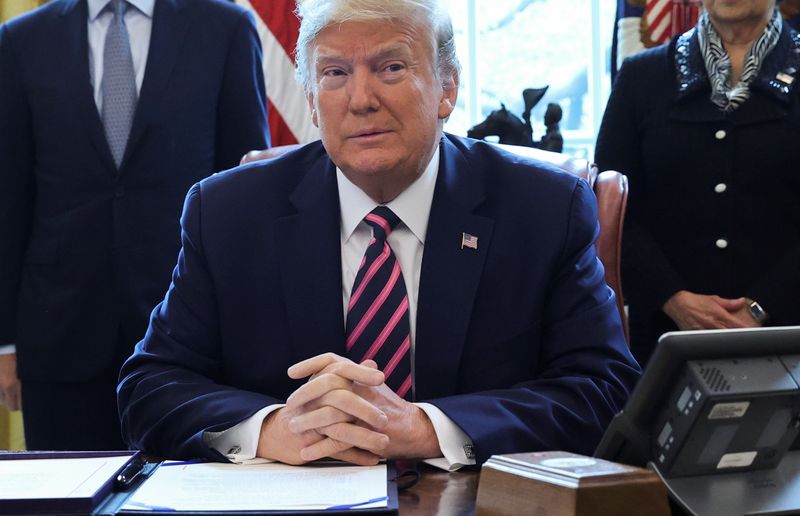WASHINGTON (Reuters) – U.S. President Donald Trump made a hardline immigration agenda central to his 2020 re-election campaign and his administration has pushed ahead with a wide-ranging crackdown even as the United States has become the epicenter of the novel coronavirus outbreak worldwide.
While U.S. Immigration and Customs Enforcement (ICE) has dialed back arrest operations and agreed to review cases of some at-risk immigrants in custody, it is still detaining tens of thousands and proceeding with deportation flights.
Pro-immigrant advocates have called for detainees – particularly low-level offenders – to be released from custody given the risks of contracting the virus inside. Foreign governments have pressed Washington to ensure migrants deported to their countries are not infected with COVID-19, the deadly respiratory disease caused by the new coronavirus.
Have questions about ICE enforcement during the pandemic? Here are answers.
HOW HAS COVID AFFECTED ICE OPERATIONS?
The U.S. enforcement agency handles arrest, detention and deportation of immigration law violators. As such, its officers may come into contact with people infected with the virus, which has killed more than 50,000 people across the country in recent weeks.
ICE announced in mid-March that due to the outbreak, it would focus arrest and detention efforts on “public safety risks” and individuals with certain criminal convictions.
ICE also said this month it had instructed offices around the country to consider releasing detainees at higher risk of contracting COVID-19, such as pregnant women and seniors.
The number of immigrants in custody fell to roughly 31,000 in mid-April from 42,000 at the end of 2019.
Also, illegal border crossings have dropped dramatically and the administration has implemented new rules to quickly “expel” those caught instead of detaining them.
HAVE ICE OFFICERS AND DETAINEES CONTRACTED THE VIRUS?
ICE said 297 immigrant detainees had tested positive for COVID-19 as of Thursday. Dozens of infections were recorded in four detention centers, in New York, California, Texas and Louisiana.
Advocates have questioned whether the new coronavirus has spread more widely within ICE facilities. The agency has only conducted roughly 425 tests on all detainees, a spokeswoman said this week.
ICE said 88 employees had tested positive for the virus, including 35 who work in detention centers. Those figures do not include contractors.
HOW HAS THE OUTBREAK AFFECTED DEPORTATION EFFORTS?
Reuters reported on Thursday that ICE would acquire 2,000 COVID-19 tests to screen some detainees before removing them to other countries, a move the agency later confirmed.
The decision to test some deportees came amid criticism from foreign governments. Guatemala said this month it would stop receiving deportees from the United States after dozens of returning migrants tested positive.
IS ICE PREPARED FOR CORONAVIRUS OUTBREAKS IN DETENTION?
ICE has dealt with outbreaks of measles and mumps in its facilities. However, the new coronavirus poses unique challenges.
Many ICE detention centers are in remote communities, far from hospitals able to handle a rush of patients with COVID-19, Reuters reported earlier this month.
Detention center outbreaks in such areas could quickly swamp local hospitals, threatening their ability to treat local residents along with detainees.
WHAT IS HAPPENING TO FAMILIES AND CHILDREN IN DETENTION?
The number of families in ICE custody has dropped in recent weeks, agency figures showed. ICE had roughly 700 family members in custody as of April 21, down 30 percent from two weeks earlier, according to figures released in a court filing.
Still, advocates have pressed for ICE to release all detained families and unaccompanied children in the custody of the U.S. Department of Health and Human Services (HHS).
In March, a Los Angeles-based federal judge called on U.S. officials to “make continuous efforts” to get children out of detention facilities.
The HHS office charged with care and custody of unaccompanied minors said it had just under 2,000 children in custody as of Thursday.
The agency said 59 children in its custody had tested positive for COVID-19. Of those, 45 had recovered and been moved out of isolation, according to a spokesman.
Some 500 children caught on the U.S.-Mexico border have been quickly “expelled” under new enforcement rules aimed at curbing the virus. Some have been sent back on planes to their home countries and others were turned back to Mexico.
(Reporting by Ted Hesson; Editing by Mica Rosenberg and David Gregorio)






















